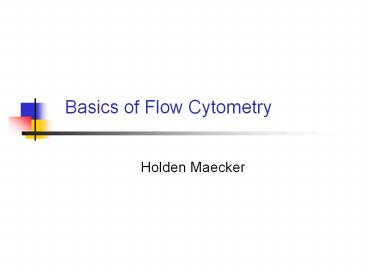Basics of Flow Cytometry - PowerPoint PPT Presentation
Title:
Basics of Flow Cytometry
Description:
Data analysis: FSC files, gating, statistics. Definitions ... as they move in fluid suspension, allowing multiple measurements to be made per cell. ... – PowerPoint PPT presentation
Number of Views:6218
Avg rating:3.0/5.0
Title: Basics of Flow Cytometry
1
Basics of Flow Cytometry
- Holden Maecker
2
Outline
- Definitions, what can be measured by flow
cytometry - Fluidics Sheath and sample streams, flow cells,
sorting - Optics Lasers, filters
- Electronics PMTs, signal processing
- Fluorochromes spectra, spillover
- Data analysis FSC files, gating, statistics
3
Definitions
- Flow cytometry study of cells as they move in
fluid suspension, allowing multiple measurements
to be made per cell. - FACS fluorescence-activated cell sorting
4
What measurements can be made?
- Forward light scatter (FSC) proportional to
cell size - Side light scatter (SSC) proportional to cell
granularity - Fluorescence
- Binding of fluorescent-labeled antibodies
- Ca-sensitive dyes within cells
- Fluorescent proteins expressed by cells
- Binding of DNA dyes
5
Scatter profile of lysed whole blood
Side Scatter
Forward Light Scatter
6
Fluorescence data display
Negative control histogram
PE
Number of Events
FITC Fluorescent Intensity ?
FITC
7
Major components of a flow cytometer
- Sample intake port
- Sheath and waste reservoirs
- Flow cell
- Laser(s)
- Optical filters
- PMTs (photomultiplier tubes) or photodiodes
- Signal processor
8
Cytometer fluidics create laminar flow
Sample stream
Flow Cell
Sheath stream
Laser beam
Cell
9
Cell sorting
10
Typical 2-color cytometer configuration
FL1 PMT
488/10 nm band pass filter
530/30 nm band pass filter
SSC PMT
1 ND front surface mirror
FL2 PMT
560nm short pass dichroic mirror
585/42 nm band pass filter
488nm band pass filter
488nm laser beam
FSC PD
flow cell
11
Background and autofluorescence
- All cells have a certain level of background
fluorescence, due to - Autofluroescence from pigments and fluorescent
moieties on cellular proteins - Non-specifically bound antibodies, and free
antibody in the sample stream - The level of autofluorescence varies with the
wavelength of excitation and collection - Highest in FITC, PE detectors lowest in far red
(APC, Cy7) detectors
12
Fluorescence sensitivity
- Detection Efficiency (Q) number of
photoelectrons generated per molecule of
fluorophore - Dependent upon fluorophore, filters, PMT
sensitivity, voltage gain setting, etc. - Background (B) non-specific signal intrinsic to
the system - Dependent upon autofluorescence, unbound
fluorophore, stray light, etc.
13
Common fluorophores for Ab conjugation
FLUOROCHROME Type of molecule Typical excitation laser Approximate emission peak
Fluorescein isotyocyanate (FITC) Small organic 488 nm 518 nm
AlexaFluor 488 Small organic 488 nm 518 nm
Phycoerythrin (PE) Protein 488 or 532 nm 574 nm
PE-Texas Red Protein tandem 488 or 532 nm 615 nm
PE-Cy5 Protein tandem 488 or 532 nm 665 nm
Peridinin chlorophyll protein (PerCP) Protein 488 or 532 nm 676 nm
PerCP-Cy5.5 Protein tandem 488 or 532 nm 695 nm
PE-Cy7 Protein tandem 488 or 532 nm 776 nm
Allophycocyanin (APC) Protein 633 nm 659 nm
AlexaFluor 647 Small organic 633 nm 667 nm
AlexaFluor 700 Small organic 633 nm 718 nm
APC-Cy7 Protein tandem 633 nm 784 nm
Pacific Blue Small organic 405 nm 454 nm
AmCyan Protein 405 nm 487 nm
14
Fluorescence spillover
Emission of FITC in PE channel
15
Compensating for spillover
uncompensated
compensated
FITC mean fluorescence PE mean
fluorescence ---------------------------- ------
---------------------- negative positive negativ
e positive ----------- ---------- ----------- --
-------- uncompensated 125 3540 185 165
0 compensated 125 3560 135 135
Spillover
X 100
16
FCS files
- FCS 2.0 and FCS 3.0 conventions
- Often referred to as list-mode files
- Contain all of the measurements (FSC-H, FSC-A,
SSC-H, SSC-A, FL1-H) for each individual cell
processed in a given sample
17
Hierarchical gating
18
Web reference tools
- BD Spectrum Viewer
- http//www.bdbiosciences.com/spectra
- Maecker lab weblog
- http//maeckerlab.typepad.com
- (protocols, manuscripts, literature updates)































